Sample Finder |
2025-06-30 |
This topic describes how to find samples in bulk using sample properties, attributes of their parents or sources, or in the Professional Edition, based on related assay results. The Sample Finder helps you build a set of criteria to find samples of interest across all the Sample Types in your system. For example, you might want to find all samples of different types from a specific source or lab, or see if you have enough samples in the system from male, BALB/c mice to perform a given experiment.The criteria you define will persist for the next time you visit the Sample Finder making it easy to focus on what you need regularly. You can also save your search criteria by name to keep track of common searches.

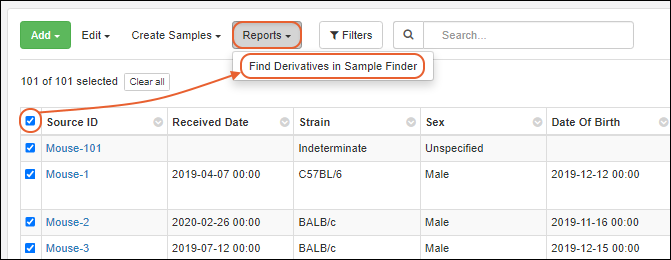
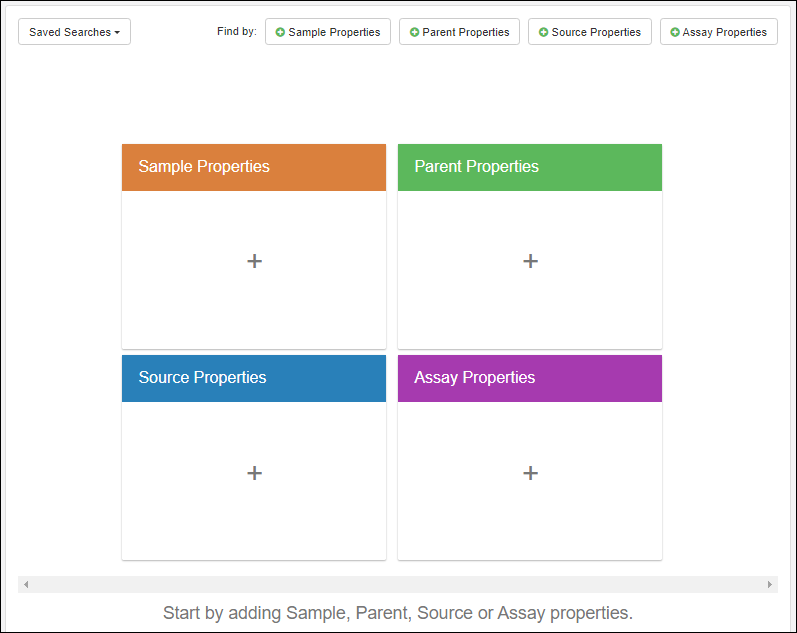 Click a tile to find samples using one of the categories of filtering criteria, detailed below.In the popup, choose the specific type and field on which you want to filter. You can filter some fields by values and any field using filtering expressions.
Click a tile to find samples using one of the categories of filtering criteria, detailed below.In the popup, choose the specific type and field on which you want to filter. You can filter some fields by values and any field using filtering expressions.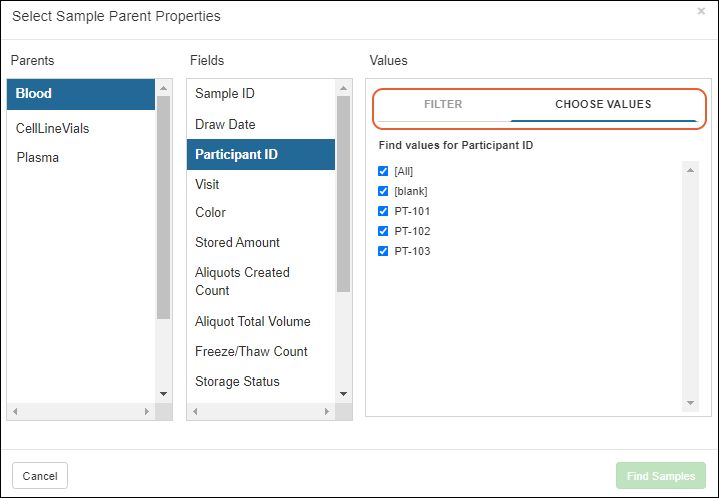 Click Find Samples to add your filter.
Click Find Samples to add your filter.
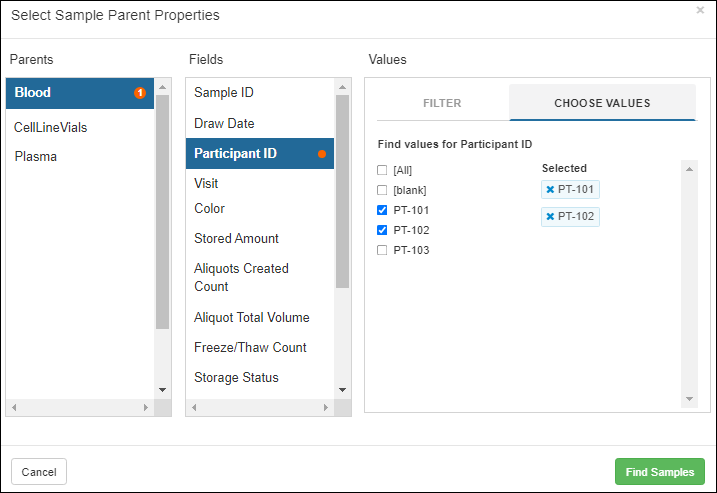
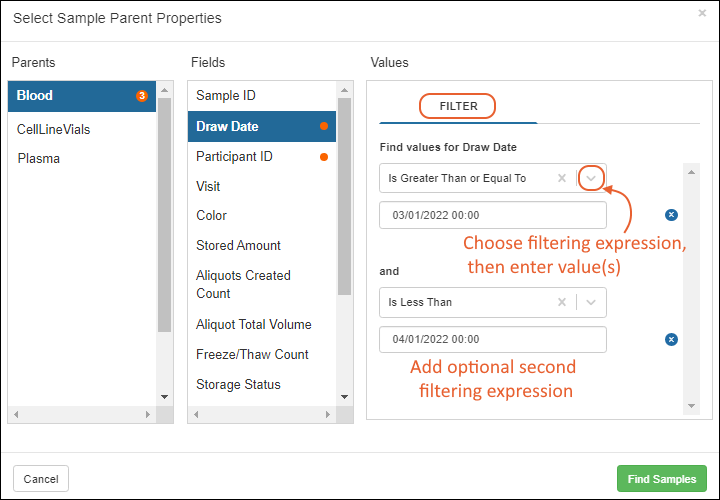 If your first filtering expression fully constrains the result (such as an "Equals" filter) you will not have the option to add a second expression.
If your first filtering expression fully constrains the result (such as an "Equals" filter) you will not have the option to add a second expression.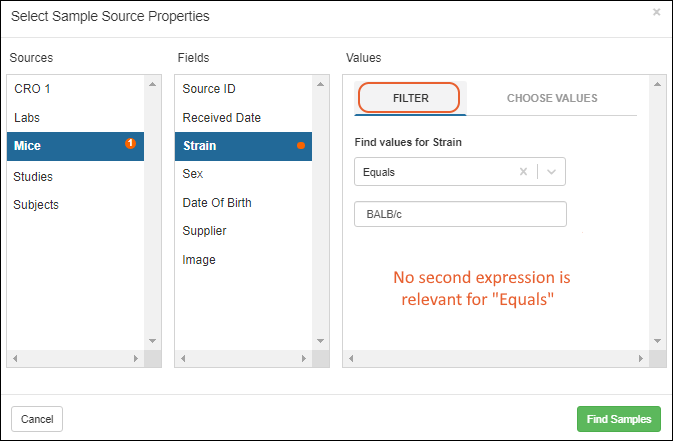
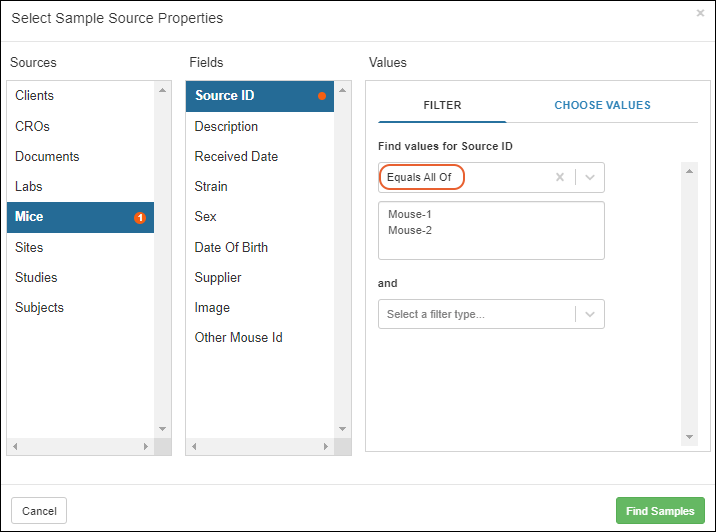 All samples which have all of the provided IDs as ancestors will be returned.
All samples which have all of the provided IDs as ancestors will be returned.
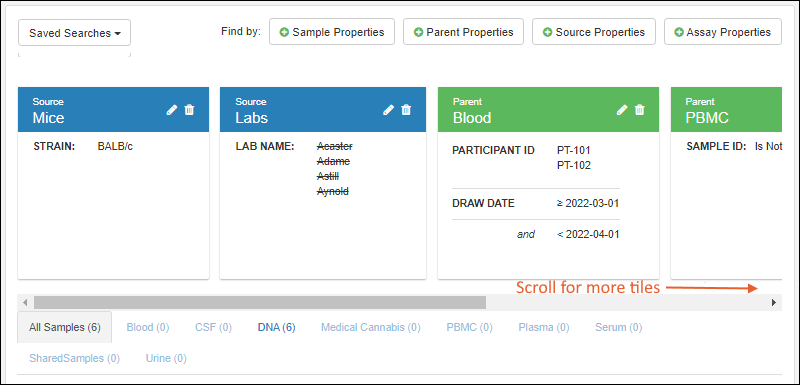 To delete all criteria associated with a given source or parent, click the for that tile.
To delete all criteria associated with a given source or parent, click the for that tile.
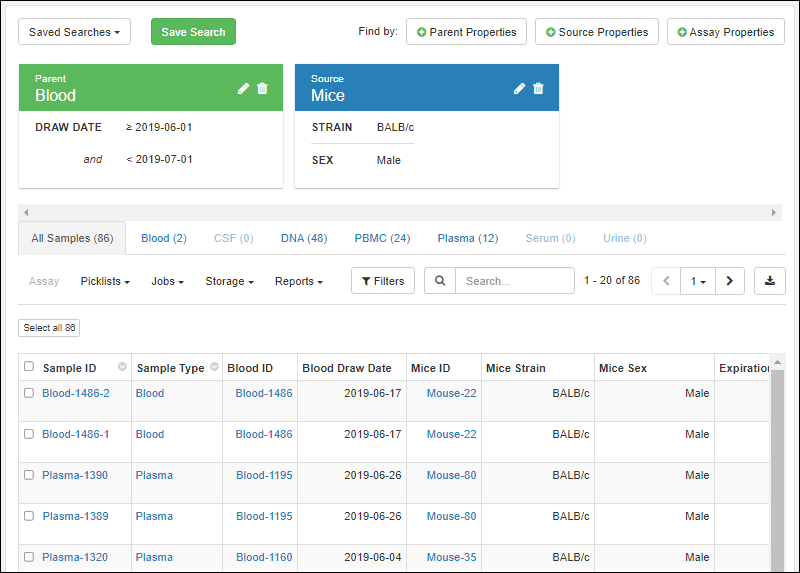 The data grid will show the parent and source columns included in your criteria, as well as common properties of the samples themselves, such as status and creation date. You can use these results to refine the sample finder criteria tiles. When ready, you can save your current search criteria so that you can apply them later. If you want to save a given result set of samples, use a picklist.Learn about options for actions, filtering, searching, and sorting sample grids in this topic:
Actions available on the Sample Finder results vary based on user permissions, but include actions available on other kinds of sample grids for the same user, such as:
The data grid will show the parent and source columns included in your criteria, as well as common properties of the samples themselves, such as status and creation date. You can use these results to refine the sample finder criteria tiles. When ready, you can save your current search criteria so that you can apply them later. If you want to save a given result set of samples, use a picklist.Learn about options for actions, filtering, searching, and sorting sample grids in this topic:
Actions available on the Sample Finder results vary based on user permissions, but include actions available on other kinds of sample grids for the same user, such as:
 Give your search a name, then click Save in the popup. This name will be used to retrieve this set of criteria later, and perform a new search using them, possibly finding a different set of samples depending on how your data has changed over time.You'll now see the name of your custom search as the name of the Saved Search menu. Options:
Give your search a name, then click Save in the popup. This name will be used to retrieve this set of criteria later, and perform a new search using them, possibly finding a different set of samples depending on how your data has changed over time.You'll now see the name of your custom search as the name of the Saved Search menu. Options:
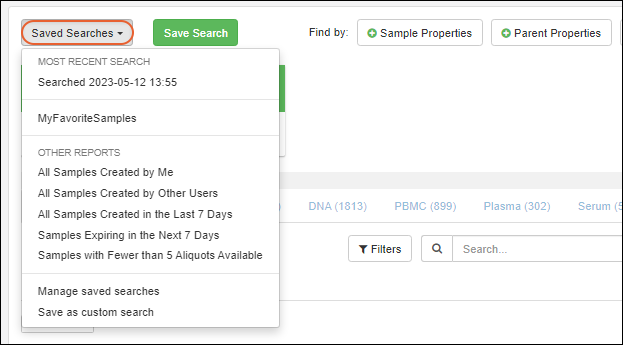
 If you make changes to an existing saved search, you'll be able to use the Save Search button as usual, or select the dropdown and Save as... a new named search.
If you make changes to an existing saved search, you'll be able to use the Save Search button as usual, or select the dropdown and Save as... a new named search.
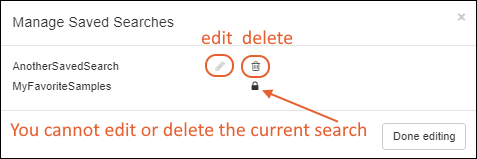
- Video Tutorial
- Open the Sample Finder
- Find Derivatives in Sample Finder
- Sample Finder
- Filtering Criteria
- Choose Values
- Filter With Expressions
- Find Samples with Multiple Common Ancestors
- Edit Criteria
- Search Results
- Saved Searches
Video Tutorial
In this video, you will see how to create persistent, reusable reports using the Sample Finder.Note that updates since the making of this video mean that you select Reports > Find Derivatives in Sample Finder to open this report (instead of clicking "Find Derivatives"). Also, criteria can now include both common and user-defined properties of samples, parents, and sources.Open the Sample Finder
To open the Sample Finder, select it from the search menu anywhere in the application. You can also click Go to Sample Finder from the main dashboard.Find Derivatives in Sample Finder
You can prepopulate the Sample Finder with a starting search filter by selecting a set of samples or sources and selecting Reports > Find Derivatives in Sample Finder. On some grids, this option will be under the More menu. For example, to find all the samples created from any "Mouse" source, select all rows on the Source page for Mice. When you select Find Derivatives in Sample Finder, you'll jump to the sample finder with all sample "children" from your selections where you can add more search criteria.Sample Finder
When you open the Sample Finder without preselecting samples, you'll see the tile dashboard:Filtering Criteria
- Sample Properties: Find Samples based on properties defined in the Sample Type, whether built-in (common to all Sample Types) or user-defined. You can either narrow to a specific type or search across common properties of all Sample Types.
- Ex: Find all Samples with an expiration date in the next 7 days.
- Parent Properties: Find Samples based on the properties of their parent Samples.
- Both built-in and user-defined properties of the parent Sample Type are available for searching here.
- Ex: Find all child Samples derived from any Blood Sample parent with a Draw Date during a certain timeframe.
- Source Properties: Find Samples based on properties of a Source parent:
- Both built-in and user-defined properties of the Source Type are available for searching here.
- Ex: Find Samples taken from male, BALB/c mice.
- Assay Properties (Professional Edition Feature): Find Samples based on Assay Result data.
- Ex: Find Samples with a Platelet count on a CBC assay in specific range of values.
- You an also use a checkbox to find Samples without any results for a selected assay.
Choose Values
For some fields with a limited set of value options, you can use a checkbox interface to select one or more values to include. For example, to choose only samples with a Blood parent where the ParticipantID is either "PT-101" or "PT-102".
Filter with Expressions
You can also use the Filter tab to specify a filtering expression and enter a value. If desired, you can add a second filter to this column to indicate a range or other combination of expressions that will be AND-ed together. If your first filtering expression fully constrains the result (such as an "Equals" filter) you will not have the option to add a second expression.
If your first filtering expression fully constrains the result (such as an "Equals" filter) you will not have the option to add a second expression.
Find Samples with Multiple Common Ancestors
Use the specialty Equals All Of filter operator to find samples that share all of a provided set of multiple ancestors of a given type in common. This option is only available on the Parent Properties and Source Properties cards and can only be used for ID fields, including Sample ID and Source ID. For example, if you wanted to find samples who had both Mouse-1 and Mouse-2 as ancestors, you could use this filter operator. Up to 10 IDs can be provided separated by either new lines or semicolons.Edit Criteria
Once you've defined any sample finding criteria, you can use the buttons in the upper right to add more filters on other columns of any other available type.Each type that you filter on will have a tile, listing the active filters on columns in that type.You can use the for any tile to edit the criteria it will use to find samples. For example, you could add additional filters on other fields of a parent or source filter you already created.To add search criteria for another type of source or parent, start from the Source/Parent Properties button.- Each type will have a separate "tile" showing filters applied. When a filter includes "does not equal", you will see the values with strikethrough styling.
- To set a filter to simply require that the sample have any parent of a given type, use "SampleID is not blank" for that filter.
Search Results
As you build your set of criteria, you will see the results grid below the tiles. There is a tab for All Samples as well as individual tabs for all defined sample types. Each shows the count of samples of that type that were found using your criteria.- Creating new derivatives or aliquots (only available on the tab for a specific sample type)
- Importing assay data
- Adding to picklists or workflow jobs
- Storage Editors can manage storage status, including checking out the found samples
Saved Searches
To save a Sample Finder search, click the Save Search button (only shown when you have generated a set of search criteria).- Most Recent Search:
- The date and time of your most recent search is shown; click to open it.
- Saved Searches:
- You'll see a list of any named saved searches you've created here.
- Note that saved searches are not shared with other users.
- Other Reports
- Built in sample reports are listed here. Learn more in this topic: Built-in Sample Reports
- Manage saved searches
- Save as custom search